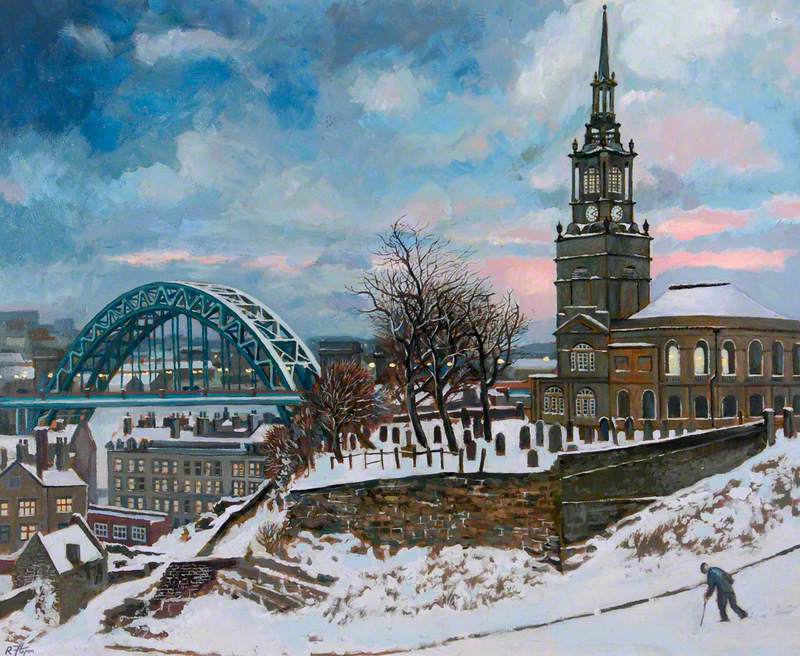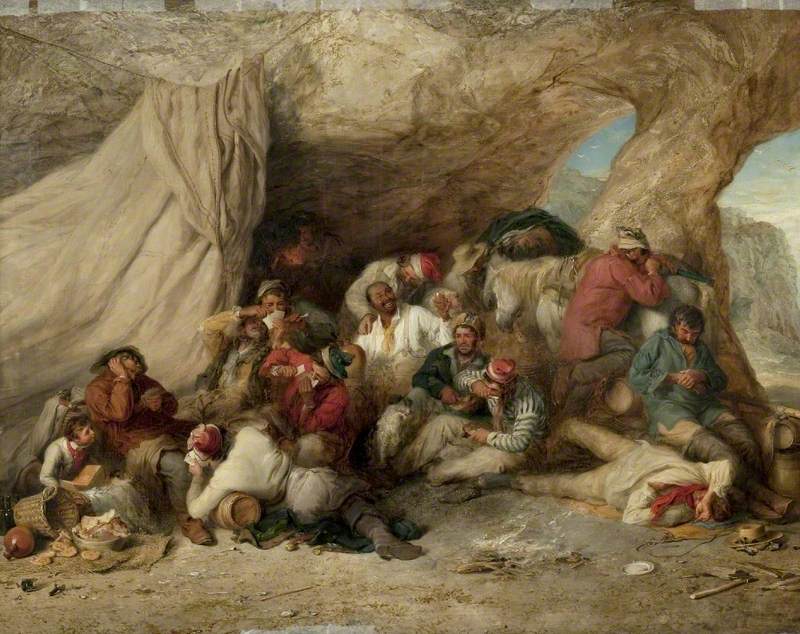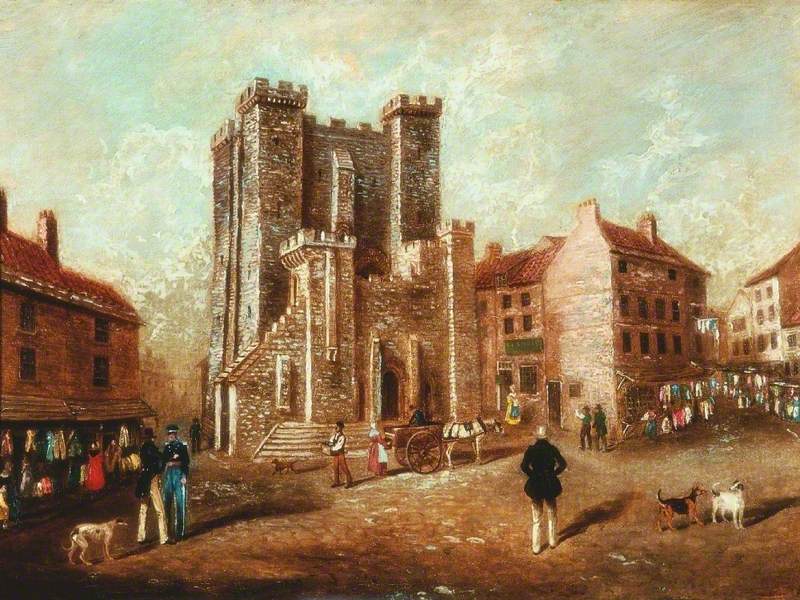Newcastle is a city of change and transformation whose inhabitants have one eye on engineered futures, while another eye looks at the ruins of the past (the train tracks cutting through the grounds of the castle symbolise this point). As historians we are excited to be based in the city and we hope you are too. Although it is still surrounded by parts of the old Roman wall, Newcastle has long expanded past its traditional core hugging the River Tyne at the base of the Castle. It is no surprise then that Newcastle - its places and people - have featured prominently in art. This digital exhibition offers a taster of the kind of visual sources available to students and some suggested walks in the city.
-
View of the Tyne
View of Newcastle upon Tyne and Gateshead c.1970This image is in the Shipley Art Gallery in Gateshead (just across the river from Newcastle). Can you work out where the artist stood based on the features in the painting? It is a striking painting, despite its shades of brown, and gives an insight into old Gateshead before redevelopment. It is also a notable painting of the city and its twin on the other side around the time that "Get Carter" was being filmed. This movie, starring Michael Caine, is famous for its scenes set in Newcastle and Gateshead.
Visit: walk along the banks of the Tyne and Shipley Art Gallery
Watch: Get Carter
Derek Albert Hedgecock (1932–1999)
Oil on board
H 80 x W 121 cm
Shipley Art Gallery
-
The High Level Bridge
Excavations for the High Level Bridge, Newcastle upon Tyne c.1846Newcastle is a city of bridges - one can trace the development of the city from the original Roman bridge ('Pons Aelius') to the striking Millenium Bridge (unveiled in 2001). This painting depicts the building of the High Level Bridge, an engineering feat for the period and a sign of Newcastle's emerging status as powerhouse of Victorian Britain. Designed by Robert Stephenson, the High Level Bridge carried trains on the upper deck and pedestrians and horse carriages on the lower deck. Taking the train into Newcastle on this bridge is a thrilling way to arrive, while talking a walk across the bridge gives you a slower opportunity to get a sense of the city.
Visit: walk across the High Level Bridge
Thomas Miles Richardson I (1784–1848)
Oil on canvas
H 96.7 x W 83.2 cm
Laing Art Gallery
-
St Nicholas Street
St Nicholas Street, Newcastle upon Tyne 1902The Cathedral Church of St Nicholas that we see today is an eighteenth century restoration of an 11th century church, and the spire of St Nicholas is something of a landmark throughout the city. This painting by Louis Hubbard Grimshaw is quite atmospheric, showing the romance of a dusky urban street scene. If you go to Nicholas Street today you will make out the same elements in this scene. However, today, noisy road markings and a bus stop shelter show how automobiles have changed how we inhabit the streets.
Visit: St Nicholas Cathedral
Louis Hubbard Grimshaw (1870–1944)
Oil on board
H 29.1 x W 42.6 cm
Laing Art Gallery
-
The Black Gate
The Black Gate, Newcastle Upon TyneClose to St Nicholas is the Black Gate - the entrance to the Castle Garth and the core of Newcastle's historic area. Today this is perhaps the chief tourist experience in Newcastle, but in the nineteenth century this area was a slum and many photographs in the City Library collection attest to the overcrowding and poverty here. The construction of the High Level Bridge behind this area encouraged efforts to demolish the slum - however we are lucky that the Black Gate survived the slum clearances of the 1880s and was protected by the Society of Antiquaries. A visit to the Black Gate and castle complex is well worth it.
Visit: The Castle
George Balmer (1805–1846) (attributed to)
Oil on canvas
H 75 x W 64 cm
Lady Lever Art Gallery
-
Science in Newcastle
A Meeting of the Newcastle Phrenological Society 1835This painting depicts a gathering of men who were slightly obsessed with the bumps on human skulls. Phrenology was a science (or 'pseudo-science') based on the idea that a persons character was determined by the shape of their cranium. Phrenologists would examine the skulls of executed criminals, geniuses, and other celebrities. Newcastle had a thriving scientific culture in the Victorian period. Two buildings from this period worth visiting are beside each other on Westgate Road beside the Central Station - the Literary and Philosophical Society and the Mining Institute.
Visit: The Literary and Philosophical Society
British (English) School
Oil on panel
H 22 x W 27.5 cm
National Trust, Cragside
-
Newgate Gaol
Newgate, Newcastle upon Tyne c.1820Like other towns and cities in England, Newcastle had a gaol to incarcerate criminals and debtors. Newgate was a medieval prison built over one of the old gates to Newcastle in the town wall. Prisoners condemned to be executed would be taken from Newgate up Gallowgate to the gallows on the Town Moor. You can follow this route yourself by walking past the modern St James's Park and up the hill to the NHS Blood Donor centre, where the gallows was sited until the 1840s. Newgate was a notoriously damp and overcrowded place and town officials earmarked it for demolition in the 1820s (it was located where the branch of 'Next' is in Eldon Square today).
Visit: walk up Gallowgate along the route of the condemned
James Russell Ryott (c.1788–1851)
Oil on board
H 33.7 x W 46.5 cm
Laing Art Gallery
-
Pandon Dene - Newcastle's lost valley
New Bridge over Pandon Dene, Newcastle upon Tyne c.1812Newcastle was once a small town divided by a series of natural ravines and streams known as 'denes' or 'burns' running downhill to the Tyne. The old Roman wall bounded the town and along its eastern wall skirted along a tree-lined vale known as Pandon dene. The banks of this dene created a barrier and the vale was used as spot for walks by the inhabitants. The route from Pandon dene wound its way from Barras Bridge (near modern day Haymarket) along a stream in a southerly direction before it eventually reached the Tyne. Today Pandon dene lies under a highly-developed part of the city including the A167 motorway, Manors railway station, and parts of Northumbria University.
Visit: Plummer Tower on Croft Street
unknown artist
Oil on canvas
H 61 x W 91.6 cm
Laing Art Gallery
-
Grainger Market
The Banquet Given on the Occasion of the Opening of the Grainger Market, Newcastle upon Tyne, 1835 c.1835Grainger market has been the main indoor food and produce market in Newcastle for almost 200 years. Although its purpose is traditional, it is a symbol of modern urban development because it is considered the first planned covered market (or shopping centre) in the world. Built on a nun's burial ground, the market was designed by leading local architect John Dobson and opened in October 1835. This painting depicts the opening banquet for 2000 people, showing the sense of scale and pride in this construction. Grainger market continues to have a central place in the life of the city.
Visit: Grainger market
Henry Perlee Parker (1795–1873)
Oil on canvas
H 96 x W 159.8 cm
Laing Art Gallery
-
Great Fire of 1854
The Great Fire of Newcastle upon Tyne 19th CThe Great Fire of Newcastle and Gateshead was a series of events that started on 6th October 1854 when a warehouse full of chemicals exploded on Gateshead side of the river. This destroyed much of the quayside and sent flaming rocks and boulders across the river into Newcastle spreading more fires which killed 53 people. More people died in this fire than in the Great Fire of London in 1666, and this painting gives you a sense of the scale of devastation the fire caused. Newcastle University's special collections in Robinson Library has many interesting primary sources on this fire.
Visit: St Mary's Heritage Centre, Gateshead
unknown artist
Oil on mother-of-pearl & glass
H 16.4 x W 23.6 cm
Laing Art Gallery
-
Whaling on Tyneside
Whalers Entering the Tyne 1830Newcastle was a regional centre for the whaling industry in the northeast of England. Between 1780-1850 whalers brought back whale oil and blubber for processing in refineries along the Tyne. A major refinery in Gateshead was known for processing and then selling 'Greenland yard oil' for use as an industrial lubricant, in the soap factories, and as an illuminant in the public lamps lighting Newcastle. Two of the most famous Newcastle whalers - the Lord Gambier and the Lady Jane - engaged in this trade until the profits collapsed in the 1840s. Whalers traded with Inuit in the Arctic and some of these items (including a kayak and a stuffed polar bear) can be seen in the Great North Museum.
Visit: Great North Museum
John Wilson Carmichael (1799–1868)
Oil on canvas
H 74.5 x W 130.5 cm
Torre Abbey Museum
-
All Saints Church
The Tyne Bridge and All Saints Church, Newcastle upon Tyne, Tyne and Wear 1979This charming winter scene depicts the iconic Tyne Bridge (completed in 1928) and beautiful All Saints Church. This church is said to have been built on the site of a Roman pantheon overlooking the Tyne at a height. After serving as the church and burial ground for one of Newcastle's most populous and impoverished parishes (All Saints), the church was deconsecrated in the 1960s, and has only recently become a church once again - Presbyterian this time.
Visit: All Saints Church and Dog Leap Stairs
Richard Flynn
Oil on canvas
H 67 x W 82 cm
Newcastle City Council
-
Fish Market, Quayside
The Old Fish Market, Sandhill, Newcastle upon Tyne c.1826–1830Imagine the noise, the aromas, the cries, and the shouts. This colourful painting depicts the fish market by The Side, near the quays in Newcastle. Despite the liveliness of the trade (and the smell of the fish), this was an elegant building with eight doric columns, water pump, and ventilation shafts. This building was replaced in the later 1800s by the Fish Market at fish quay (most recently a nightclub, but with the statue of Neptune on top still guarding his domain).
Visit: former Fish Market, Quayside.
Henry Perlee Parker (1795–1873)
Oil on canvas
H 115 x W 152.1 cm
Laing Art Gallery


















